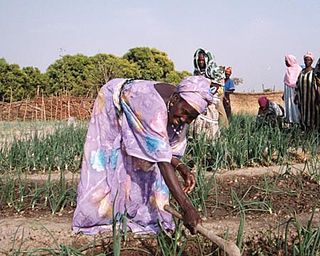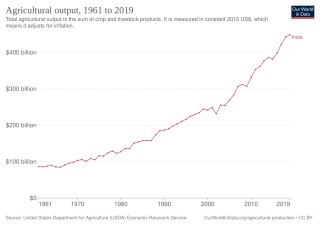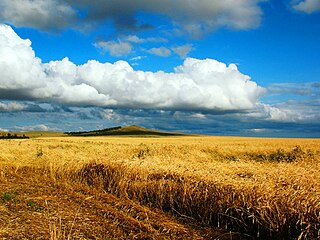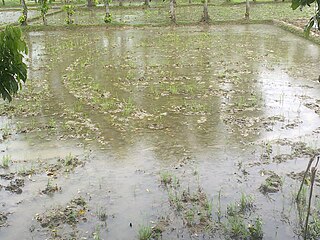
The Agricultural Adjustment Act (AAA) was a United States federal law of the New Deal era designed to boost agricultural prices by reducing surpluses. The government bought livestock for slaughter and paid farmers subsidies not to plant on part of their land. The money for these subsidies was generated through an exclusive tax on companies which processed farm products. The Act created a new agency, the Agricultural Adjustment Administration, also called "AAA" (1933-1942), an agency of the U.S. Department of Agriculture, to oversee the distribution of the subsidies. The Agriculture Marketing Act, which established the Federal Farm Board in 1929, was seen as an important precursor to this act. The AAA, along with other New Deal programs, represented the federal government's first substantial effort to address economic welfare in the United States.

An agricultural subsidy is a government incentive paid to agribusinesses, agricultural organizations and farms to supplement their income, manage the supply of agricultural commodities, and influence the cost and supply of such commodities.

The history of agriculture in the United States covers the period from the first English settlers to the present day. In Colonial America, agriculture was the primary livelihood for 90% of the population, and most towns were shipping points for the export of agricultural products. Most farms were geared toward subsistence production for family use. The rapid growth of population and the expansion of the frontier opened up large numbers of new farms, and clearing the land was a major preoccupation of farmers. After 1800, cotton became the chief crop in southern plantations, and the chief American export. After 1840, industrialization and urbanization opened up lucrative domestic markets. The number of farms grew from 1.4 million in 1850, to 4.0 million in 1880, and 6.4 million in 1910; then started to fall, dropping to 5.6 million in 1950 and 2.2 million in 2008.
The Agricultural Marketing Service (AMS) is an agency of the United States Department of Agriculture; it maintains programs in five commodity areas: cotton and tobacco; dairy; fruit and vegetable; livestock and seed; and poultry. These programs provide testing, standardization, grading and market news services for those commodities, and oversee marketing agreements and orders, administer research and promotion programs, and purchase commodities for federal food programs. The AMS enforces certain federal laws such as the Perishable Agricultural Commodities Act and the Federal Seed Act. The AMS budget is $1.2 billion. It is headquartered in the Jamie L. Whitten Building in Washington, D.C.

An agricultural cooperative, also known as a farmers' co-op, is a producer cooperative in which farmers pool their resources in certain areas of activity.

The history of agriculture in India dates back to the Neolithic period. India ranks second worldwide in farm outputs. As per the Indian economic survey 2020 -21, agriculture employed more than 50% of the Indian workforce and contributed 20.2% to the country's GDP.

Agriculture in Kazakhstan remains a small scale sector of Kazakhstan's economy. Agriculture's contribution to the GDP is under 10% – it was recorded as 6.7%, and as occupying only 20% of labor. At the same time, more than 70% of its land is occupied in crops and animal husbandry. Compared to North America, a relatively small percentage of land is used for crops, with the percentage being higher in the north of the country. 70% of the agricultural land is permanent pastureland.

Agriculture is one of the dominant parts of Senegal's economy, even though Senegal lies within the drought-prone Sahel region. As only about 5% of the land is irrigated, Senegal continues to rely on rain-fed agriculture. Agriculture occupies about 75% of the workforce. Despite a relatively wide variety of agricultural production, the majority of farmers produce for subsistence needs. Millet, rice, corn, and sorghum are the primary food crops grown in Senegal. Production is subject to drought and threats of pests such as locusts, birds, fruit flies, and white flies. Moreover, the effects of climate change in Senegal are expected to severely harm the agricultural economy due to extreme weather such as drought, as well as increased temperatures.
Title 7 of the United States Code outlines the role of agriculture in the United States Code.

In 2020, approximately 80% of Chad's labor force was employed in the agricultural sector. This sector of the economy accounts for 52.3% of the GDP, as of 2017. With the exception of cotton production, some small-scale sugar cane production, and a portion of the peanut crop, Chad's agriculture consists of subsistence food production.

Agriculture in Ethiopia is the foundation of the country's economy, accounting for half of gross domestic product (GDP), 83.9% of exports, and 80% of total employment.

Agricultural land is typically land devoted to agriculture, the systematic and controlled use of other forms of life—particularly the rearing of livestock and production of crops—to produce food for humans. It is generally synonymous with both farmland or cropland, as well as pasture or rangeland.
In the United States, the Acreage Reduction Program (ARP) is a no-longer-authorized annual cropland retirement program for wheat, feed grains, cotton, or rice in which farmers participating in the commodity programs were mandated to idle a crop-specific, nationally set portion of their base acreage during years of surplus. The idled acreage was devoted to a conserving use. The goal was to reduce supplies, thereby raising market prices. Additionally, idled acres did not earn deficiency payments, thus reducing commodity program costs. ARP was criticized for diminishing the U.S. competitive position in export markets. The 1996 farm bill did not reauthorize ARPs. ARP differed from a set-aside program in that under a set-aside program reductions were based upon current year plantings, and did not require farmers to reduce their plantings of a specific crop.

The Agricultural Act of 1956 created the Soil Bank Program, addressed the disposal of Commodity Credit Corporation (CCC) inventories of surplus stocks, contained commodity support program provisions, and contained forestry provisions. The Soil Bank Act authorized short- and long-term removal of land from production with annual rental payments to participants. The Acreage Reserve Program, for wheat, corn, rice, cotton, peanuts, and several types of tobacco, allowed producers to retire land on an annual basis in crop years 1956 through 1959 in return for payments. The Conservation Reserve Program allowed producers to retire cropland under contracts of 3, 5, or 10 years in return for annual payments. The Soil Bank Act was repealed by Section 601 of the Food and Agriculture Act of 1965. The Conservation Reserve portion of the Soil Bank was a model for the subsequent Conservation Reserve Program (CRP), enacted in 1985.

The Agriculture and Food Act of 1981 was the 4-year omnibus farm bill that continued and modified commodity programs through 1985. It set specific target prices for 4 years, eliminated rice allotments and marketing quotas, lowered dairy supports, and made other changes affecting a wide range of USDA activities. The next year this farm bill was amended to freeze the dairy price support level and mandate loan rates and acreage reserve provisions for the 1983 crops. Again in 1984, amendments were adopted to freeze target prices, authorize paid land diversion for feed grains, upland cotton, and rice, and provide a wheat payment-in-kind program for 1984.

The Food Security Act of 1985, a five-year omnibus farm bill, allowed lower commodity price, income supports, and established a dairy herd buyout program. This 1985 farm bill made changes in a variety of other USDA programs. Several enduring conservation programs were created, including sodbuster, swampbuster, and the Conservation Reserve Program.
The Direct and Counter-cyclical Payment Program (DCP) of the USDA provides payments to eligible producers on farms enrolled for the 2002 through 2007 crop years. There are two types of DCP payments – direct payments and counter-cyclical payments. Both are computed using the base acres and payment yields established for the farm. DCP was authorized by the 2002 Farm Bill and is administered by the Farm Service Agency (FSA).
A marketing year is a period of one year, designated for reporting and (or) analysis of production, marketing and disposition of a commodity. Because of year-to-year fluctuations in production, much marketing and disposition of some commodities may reflect production that occurred during a previous calendar year. For this reason, analysis is often facilitated if the marketing year for a crop commences at about the time of harvest. However, world markets or other factors may also influence choice of beginning date for the marketing year for some commodities in some countries. Especially in the case of certain perishable fresh fruits and vegetables, the marketing year may be less than a full year in length, because economic activity of interest for reporting and analysis may be concluded within just a few months.
In United States agricultural policy, a marketing loan repayment provision is a loan settlement provision, first authorized by the Food Security Act of 1985, that allowed producers to repay nonrecourse loans at less than the announced loan rates whenever the world price or loan repayment rate for the commodity were less than the loan rate. Marketing loan provisions became mandatory for soybeans and other oilseeds, upland cotton, and rice and were permitted for wheat, corn, grain sorghum, barley, oats, and honey under amendments made by the 1990 farm bill. The 1996 farm bill retained the marketing loan provisions for wheat, feed grains, rice, upland cotton, and oilseeds. The 2002 farm bill continued marketing assistance loans and expanded their application to wool, mohair, dry peas, lentils, and small chickpeas.

The Wheat Price Guarantee Act was a 1919 bill passed by Congress that gave the government the power to regulate the price of wheat.










